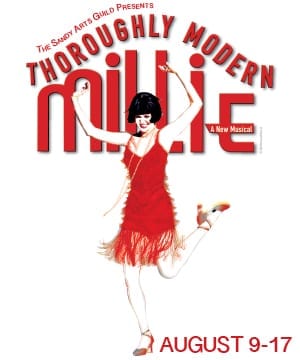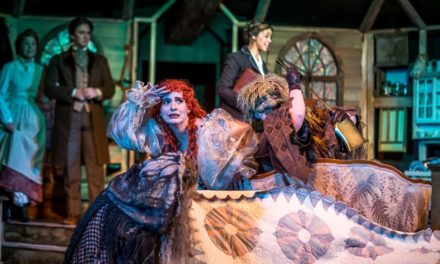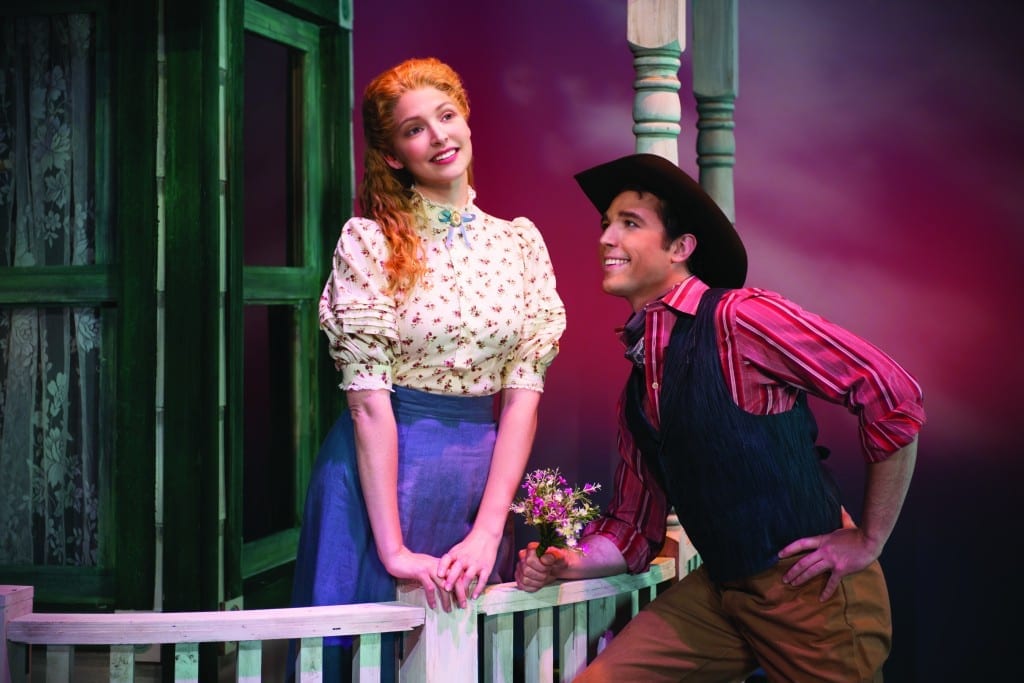SANDY — Like the other recently popular musical set in the 1920’s, The Drowsy Chaperone, the script of Thoroughly Modern Millie (written by Richard Morris and Dick Scanlan) makes light of the culture and styles of the time period. In Thoroughly Modern Millie the clothing, attitudes about marriage, and hysteria over “white slavery” are used as vehicles to provide a lighthearted evening of musical comedy. Small town Millie arrives in New York City determined to live a thoroughly modern life: marrying her boss for money, enjoying the flapper life style, and drinking at speakeasies. Although things don’t always turn out how she expected, Millie presses on and tries her best to fulfill all her dreams.
As Millie Dillmount, Taylor Thompson’s strongest moments were in her solo songs like “Jimmy” and “Gimme Gimme.” Thompson’s voice is certainly strong enough for the role, and she can belt a torch number with a passion rarely found among amateurs. I also found Thompson’s energy infectious, especially when interacting with other female cast members. On the other hand, I thought that Thompson lacked chemistry with her castmate, Kade Smith, who played Millie’s love interest, Jimmy. Smith and Thompson did not seem emotionally connected to one another during their shared scenes (e.g., the ledge scene or when Millie and Jimmy were waiting in line at the jailhouse). Perhaps this was because Smith seemed more like the boy next door than a jaded, womanizing New Yorker. But Smith has a wonderful voice that was most clear and pleasing in songs like “What Do I Need With Love?”, and his singing was one of the greatest strengths of the production.
Another strong performance was given by Jacob Shamy as Trevor Graydon. In the role of Millie’s boss, Shamy had to sing the difficult song “The Speed Test,” which he did with admirable diction. Shamy was also quite charismatic in most of his scenes, especially in “I’m Falling in Love With Someone,” his duet with Ashley Stonebraker (playing Miss Dorothy Brown). The song was among the funniest moments in the play, mostly because of the goofy manner that Shamy executed the choreography, especially given the more formal nature of his character up until that song. Stonebraker was also a great asset to Thoroughly Modern Millie because her voice and demeanor perfectly fit the silly Dorothy Brown character. In addition to the aforementioned duet with Shamy, Stonebraker was fun to watch during “How the Other Half Lives” because of her sweet attitude and excellent dancing skills.
But the actors’ dancing wouldn’t be worth mentioning if the Marilyn Montgomery‘s choreography weren’t so fun. Drawing on the period dances like the Charleston and a lot of tap, Montgomery’s choreography provided energy and excitement from the production’s first moments until its last dance scene. Dancing was also used to effectively establish the mood of locations like the speakeasy, Graydon’s workplace, and the Café Society. Although the choreography (especially the tap dancing) is not what one would expect from a professional production, it easily surpasses what one would normally see in an arts council production. Especially enjoyable were “The Nutty Cracker Suite,” the title song, and “Only in New York.”
Supplementing the spectacle of the dancing was the gorgeous set, designed by director Jan Shelton Hunsaker. The beautiful cityscape background absorbed well the colors that lighting designer Cole Adams used to convey mood. I was also pleased with how versatile the set was, especially the five set pieces that doubled as a street backdrop. Even minor set pieces, like Graydon’s office—which was only used in one scene—were beautiful to look at; many other arts councils would have built something “good enough” for a single scene. Adams’s lighting not only emphasized the beauty of the set, but also helped delineate between the musical numbers (with vibrant colored light) and the more realistic dialogue scenes (which were often lit by paler, whiter lights). And I was even impressed that the lighting often matched some of the costumes (designed by Crystal Ashby), such as the purple lighting in “I’m Falling in Love with Someone,” which perfectly matched Shamy’s purple tie, purple pocket square, and even the purple suit lining and vest back. The unity among the lighting, set, and costuming shows a high level of technical collaboration rarely seen in arts council productions. In addition to creating a united visual look to Thoroughly Modern Millie, Hunsaker also created fun scenes and stage pictures that made the musical an aesthetic feast. The transition from speakeasy to jail cell was creative and clever, and the introduction of Mrs. Meers (Patricia Rogers) was handled with a clear understanding of the silliness of the character.
Notably, Thoroughly Modern Millie had a live orchestra for the performance, which makes the Sandy Arts Guild one of the very few arts councils in northern Utah to produce a musical without recorded music. The orchestra (under the direction of Darol Denison) was so superb in playing the jazzy score (composed by Jeanine Tesori with lyrics by Dick Scanlan) that my wife occasionally mistook them for a professionally recorded ensemble. Unfortunately, the musicians did not receive the level of respect that they deserved from the audience. Much of the audience talked loudly during the overture and the entr’acte. Some of this misbehavior even extended into the opening scenes of each act, during which many audience members loudly continued their conversations, passed around concessions to other rows, and arrived quite late to their seats. It was a shame that the audience members near me in the orchestra seats did not feel it was important to show basic courtesy to other audience members and Sandy Arts Guild’s hard working performers.
Although I have praised the cast and crew, it is important to recognize that as an amateur production there were a few mistakes and shortcomings in the show. Some ensemble members were not strong dancers and struggled with even some of the basic choreography in such scenes as the introduction to the insurance company office. On the night I attended there were some technical hiccups (like a set piece that caught on a microphone and some crackles in the sound system). But these problems were fewer than what I usually see in arts council productions and will not prevent most audience members from having an enjoyable evening. Without any reservation I can recommend to UTBA’s readers that Thoroughly Modern Millie as a show worth seeing this week. Sandy Arts Guild has created a production that has few rivals on the arts council scene.






